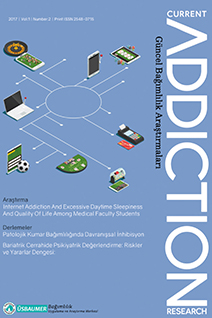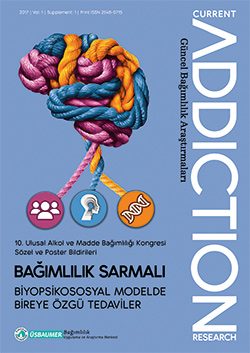Years
2018
Categories
Authors
ARTICLES
Original Article
Ayşegül Tosuner,Zehra Arıkan
2018, 2(2), s:39-46
Objective: To identify the prevalence of violence in alcohol and drug abusers and a control group; to determine the relationship between violent behavior and impulsivity, anger, aggression, traumatic childhood experiences and indicate whether prevalence of violence differs between periods of deprivation, soberness and while under the influence of alcohol/drugs.
Method: 49 alcohol abusers and 31 drug abusers aged 15-65 years were compared among themselves and also with 62 healthy controls; using a questionnaire including questions related with sociodemographic characteristics of violence, the Buss-Perry Aggression Scale, Barratt Impulsivity Scale, the State-Trait Anger Scale, the Childhood Trauma Questionnaire, Hamilton Depression Scale, the State-Trait Anxiety Inventory.
Results: The prevalence of psychological violence was 85%, physical violence 54%, sexual violence 6% and economic violence 10%. Significant differences were found in most of the variables among the groups, which were thought to be related to violent behavior.
Conclusion: In addition to medical treatment for addiction, psychotherapeutic interventions focusing on personality traits in areas such as anger control and impulsivity should be adopted. The fact that violence decreases in sober periods indicates that violence is rather a result of the nature of the substance.
Original Article
Predictors for Fear of Missing Out in the Social Networks Among University Students
Çağrı Yalçın Çınar,Elif Mutlu
2018, 2(2), s:47-53
Objective: Social networks have become indispensable of our lives with the spread of the internet. The increase of time spent on social networks led to appear a new consept of fear of missing out. The purpose of this research was to determine predictors for Fear of Missing Out (FoMO) among university students.
Method: The sample of the research was 400 Kırklareli university students who were determined by random sampling method. The data was collected using personal information form, Life Satisfaction Scale, BAPI Internet Form, FoMO Scale, Rosenberg Self-Esteem Scale, Five Factor Personality Scale and Adult ADHD Self-Report Scale. SPSS Statistical Software package was used in the analysis of the data.
Results: As a result of research, Fear of Missing Out was found to be higher among students who also find lessons boring and check social media hourly especially in during the course who have low self-esteemand in the first grade. Inaddition, it was determined that internet addiction,neurotic features, attention deficit and hyperactivity have positively associated with FoMO.
Conclusion:Internet addiction, impulsivity and neurotic features are determined as influential factors in the emergence of FoMO.
Original Article
Evaluation of Memory Functions of Alcohol Dependent Patients
Serdar Nurmedov
2018, 2(1), s:5-10
Long-term alcohol use causes varying degrees of deficit in various cognitive functions including learning, memory, visuospatial functions and abstraction. Studies using different techniques indicate that the neocortex, particularly the frontal lobe; limbic system and cerebellum are the brain regions most vulnerable to the toxic effects of alcohol.
The aim of this study is to assess the memory function in individuals with a history of alcohol dependency who meet the criteria for at least early partial remission and to compare it with healthy controls. The study also aims to investigate the association of memory function with duration of abstinence.
Twenty-four patients and 24 age, sex and education matched healthy controls were included in the study. Patients with Axis-I comorbidity, chronic neurological disease, dementia, chronic disease, Wernicke encephalopathy, Korsakoff syndrome and history of head trauma were excluded. The memory function of alcohol dependent individuals and healthy controls was assessed with Wechsler Memory Scale (WMS) and Rey Auditory- Verbal Learning Test (AVLT).
The memory subscales that show significant difference between the dependent and control groups are immediate memory span, total scores of learning trials and learning false score in AVLT and forward digit span, backward digit span, visual reproduction and memory quotient in WMS. Statistically significant difference was found in the long term recall score and long term false recognition score between the early and sustained full remission subgroups.
As a result of this study, dependent subjects are found to show more deficit in attention and memory functions compared to healthy controls. These findings are consistent with the literature on this subject.
Original Article
Sociodemographic Examination of Patients Applying to Probation Policlinic in Erzurum Province
Fatma Eren,Nermin Gündüz,Hatice Turan,Erkal Erzincan
2018, 2(1), s:11-16
Objective: In this first study on the patients who applied to the Probation Ward in the Eastern Anatolian Region of Erzurum province, it is aimed to compare the sociodemographic data of the patients with the substance use characteristics and other legal crimes.
Method: Between December 2015 and February 2016, 132 patients who applied for the first time to the Erzurum DS polyclinic were included in the study. The sociodemographic data form prepared by the researchers participating in the research was applied.
Results: All of the 132 cases involved in the study were men. While 49.2% of the patients had multiple substance use, cannabis was found to be the highest substance alone at 45.4% level. We found that smoking and alcohol use started earlier than substance use and that alcohol and cigarette use were high. Considering the impact of multiple substance use on the sociodemographic data, a significant difference was found between early substance use age, substance abuse existence in the past month, the first cigarette smoking age, self-harm behavior presence, the existence of additional criminal cases and the existence of previous psychiatric treatment history. There was a significant positive correlation between the age of first substance use and the age, the age of first cigarette use and the age of first alcohol use. Finally, when the groups with and without prison stories are compared in terms of self-harm behavior, a significant difference was found.
Conclusion: Reviewing the sociodemographic data of individuals with probation application will guide clinicians in defining the group in which more preventive measures will be taken for substance use.
Original Article
The Comparison of The Theory of Mind in Internet Addicted And Non-Addicted University Students
Nuran Korkmaz,Hızlı Sayar Gökben,Hüseyin Ünübol,Nevzat Tarhan
2018, 2(1), s:17-21
Aim: The purpose of this study is to compare the university students having diagnosed as internet addicted and internet non-addicted in terms of the theory of mind.
Methods: The study group consisted 50 undergraduate students at Üsküdar University. 25 students diagnosed an internet addicted composed the study group. 25 students who have same sex with the study group subjects, however do not have any internet addiction, composed the study group.
Results: The average age of the students is 22.74±1.45. Data was collected by using sociodemographic data form, Internet Addiction Scale and the Dokuz Eylül Theory of Mind Scale. The study group found to have statistically significantly lower scores in theory of Mind Scale, when compared to the control group.
Conclusion: This result suggests that internet addiction may affect the students’ social interaction, emotional and cognitive processing.



 2. Sayı
2. Sayı
 1. Sayı
1. Sayı
 Ek Sayı
Ek Sayı







